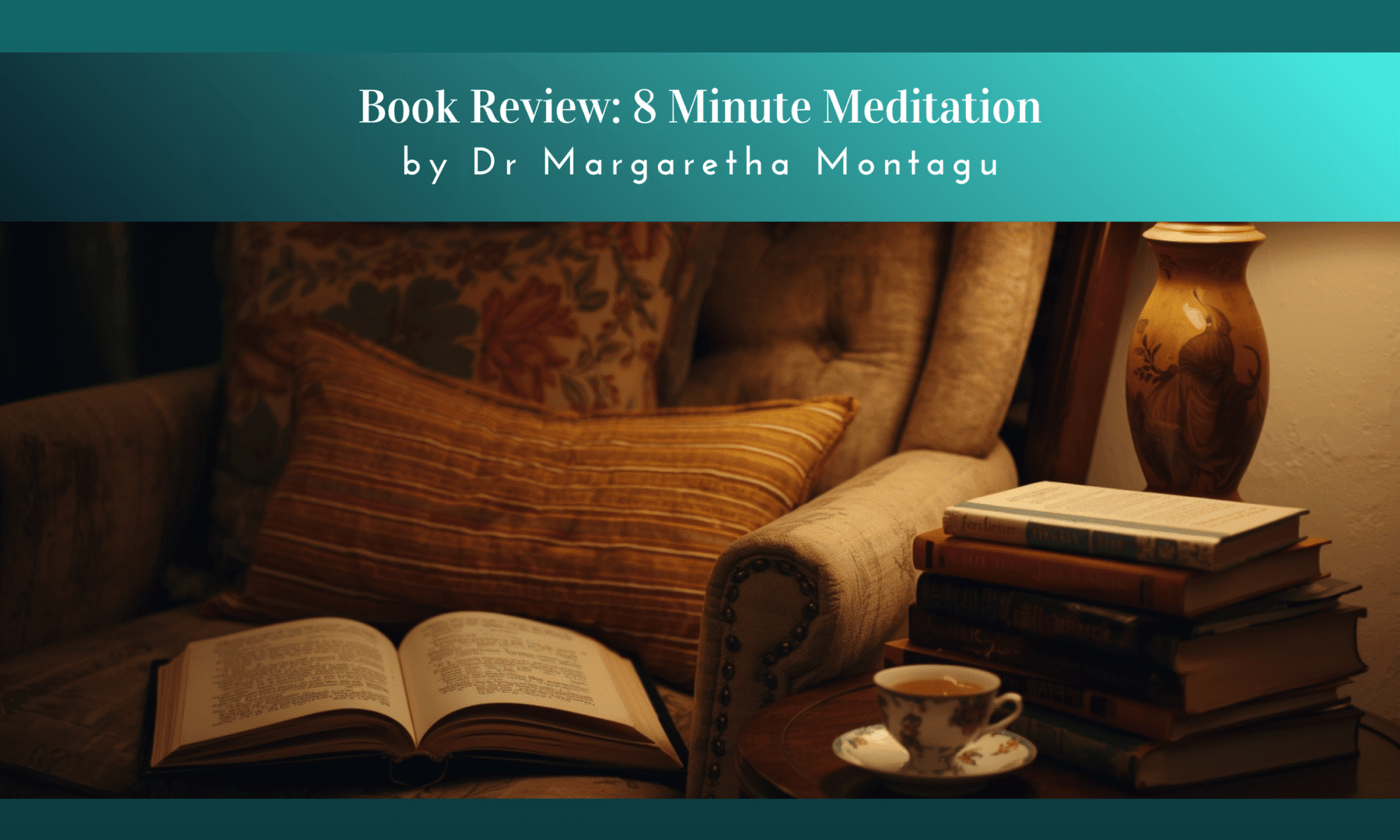Author: Victor Davich
Rating: ⭐⭐⭐⭐ (4 out of 5 stars)
Read if: You’re meditation-curious but allergic to incense, chanting, and books that assume you have unlimited free time and zero scepticism.
The Backbone of the Book
According to Victor Davich, you’re exactly eight minutes away from inner peace, reduced anxiety, and the kind of mental clarity that makes you feel like you’ve had three cups of coffee without the jitters. Eight minutes a day.
For me, this is where it all started, in 1998.
The premise is refreshingly simple: meditation doesn’t require you to become a different person, adopt new beliefs, or sit in painful positions while contemplating the universe. You just need eight minutes a day and a willingness to show up. Davich presents meditation as a skill anyone can learn—not a mystical practice reserved for monks, yogis, or people who own meditation cushions that cost more than your monthly grocery bill.
The book is structured as an eight-week program, with each week introducing a different meditation technique. Week one focuses on breath counting. Week two explores following the breath. By week eight, you’re working with thoughts and emotions in a way that feels surprisingly manageable. Each daily session literally takes eight minutes, which Davich chose deliberately because it’s short enough that you can’t reasonably claim you don’t have time, but long enough to actually experience a change.
What makes this book stand out in the crowded meditation-industrial complex is Davich’s tone. He’s not a guru. He’s not promising enlightenment. He’s a regular person who found meditation helpful and wants to strip away all the cultural baggage, spiritual requirements, and intimidation factors that keep people from trying it. His approach is secular, practical, and almost comically unpretentious. There’s no Sanskrit terminology, no discussion of chakras, and minimal talk of “energy.” Just: here’s how to sit, here’s what to do with your mind, here’s why it might help.
Useful Take-aways
The “One Breath at a Time” Foundation: Davich’s first-week technique—simply counting breaths from one to ten—sounds almost insultingly simple until you try it. Most people can’t get to ten without their mind wandering to their grocery list, that embarrassing thing they said in 2012, or whether they left the stove on. This immediate encounter with your own mental chaos is both humbling and illuminating. The genius here is that Davich doesn’t frame a wandering mind as failure; he frames it as the whole point. Noticing your mind wandered and bringing it back is the meditation. This reframing alone is worth the price of the book, because it transforms what feels like constant failure into actual success. You’re not trying to achieve a blank mind—you’re building the muscle of noticing and returning. That’s a skill that translates directly to daily life, whether you’re trying to focus on work, listen better in conversations, or not spiral into anxiety about things you can’t control.
The Progressive Structure That Actually Works: Unlike books that throw you into the deep end or offer fifty different techniques you’ll never use, Davich builds one skill on top of another. Each week’s meditation is slightly more complex than the last, but in a way that feels natural rather than overwhelming. You spend a week just watching your breath before you try to follow it through your whole body. You get comfortable with physical sensations before you tackle thoughts and emotions. This progression respects the reality that meditation is genuinely difficult at first, and your attention span has the staying power of a goldfish on espresso. By the time you reach the more advanced techniques, you’ve built enough fundamental skill that they’re actually accessible. It’s the difference between being asked to run a marathon on day one versus following a couch-to-5K program.
The “No Special Circumstances Required” Philosophy: Davich obliterates every excuse before you can make it. You don’t need a quiet space (traffic noise is fine). You don’t need to sit on the floor (a chair works perfectly). You don’t need any particular time of day (whenever works is the right time). You don’t need to believe anything (sceptics welcome). You don’t need special equipment, apps, or guidance beyond this book. This radical accessibility is both the book’s greatest strength and a legitimate insight: the things we think are necessary for meditation are usually just barriers we construct to avoid the actual challenge, which is sitting with our own minds for eight minutes. Davich’s approach strips meditation down to its absolute essence, proving that the practice itself is what matters, not the aesthetics surrounding it.
Less Useful Suggestions
The book’s main weakness is that it’s almost too stripped down. Davich is so committed to making meditation accessible and non-intimidating that he sometimes undersells the actual difficulty of maintaining a daily practice. Eight minutes isn’t long, true, but finding those eight minutes every single day—or more accurately, finding the motivation to use those eight minutes for meditation instead of scrolling your phone—is genuinely challenging. The book would benefit from more troubleshooting for the inevitable days when you don’t want to meditate, when it feels pointless, or when you’ve missed a week and feel too guilty to restart.
There’s also a somewhat dated quality to the writing (the book was originally published in 1998, though it’s been updated). Some of the research Davich cites is decades old, and while the basic techniques remain sound, the understanding of meditation’s effects on the brain has evolved significantly. Readers coming from a more modern neuroscience perspective might find themselves wanting more current scientific backing for the claims.
Additionally, while Davich insists you don’t need any particular circumstances to meditate, the book does assume a level of privacy and control over your environment that not everyone has. His casual “just find eight minutes” doesn’t fully address parents of young children, people with chronic pain that makes sitting uncomfortable, those dealing with severe anxiety or trauma (for whom meditation can actually be triggering), or anyone whose living situation doesn’t allow for even brief periods of being undisturbed. The accessibility is real, but it’s not quite as universal as he suggests.
The week-by-week structure, while helpful, is also somewhat rigid. Davich strongly encourages you to stick with each week’s technique for the full seven days before moving on, but some readers might find certain techniques click immediately while others never quite work for them. There’s limited guidance on customising the program to your own responses or mixing techniques once you’ve completed the eight weeks.
Who The 8 Minute Meditation Book Is For
Perfect for you if:
- You’ve been meaning to try meditation but every book you’ve picked up felt too woo-woo, too religious, or too demanding
- You’re a natural sceptic who needs things explained practically rather than mystically
- You can commit to eight minutes a day, but genuinely don’t have time for longer practices
- You appreciate clear, step-by-step instructions without flowery language or vague concepts
- You’ve tried meditation apps and found them either too cluttered or too simplistic
- You want to understand why you’re doing what you’re doing, not just follow commands from a soothing voice
Maybe skip it if:
- You’re looking for meditation as a spiritual practice connected to Buddhism, Hinduism, or other traditions (this is aggressively secular)
- You already have an established meditation practice and want to deepen it (this is strictly for beginners)
- You need extensive troubleshooting, community support, or guided audio to stay consistent
- You’re dealing with serious mental health challenges that require more than a basic self-help book can provide
- You prefer learning through apps, videos, or in-person instruction rather than books
The One Thing You’ll Remember in Six Months
You probably won’t remember the specific differences between “following the breath” and “sweeping the breath,” and you might not stick with the full eight-week program. But you’ll definitely remember that meditation is just noticing when your mind wanders and bringing it back—over and over, without judgment—and that eight minutes is genuinely enough to make a difference. The demystification sticks with you even if the daily practice doesn’t.
Quotable Moments
“Meditation is not about getting anywhere else. It is about being where you are and knowing it.”
“The goal of meditation is not to get rid of thoughts or emotions. The goal is to become more aware of your thoughts and emotions and to learn how to move through them without getting stuck.”
“You don’t meditate to become a better meditator. You meditate to become better at life.”
Bottom Line
This is the book to hand someone who insists they “can’t meditate” or that they’ve tried it and it “didn’t work.” Davich’s no-nonsense approach and genuinely doable time commitment make meditation accessible without dumbing it down. It won’t change your life overnight, but it might change how you relate to your own mind, which is arguably more valuable.
Recommendation: Buy it – the expanded 2014 version – if you’re a meditation beginner (support an author! we need all the help we can get) or download it – the original version – if you’re meditation-curious but uncommitted.
Personal Note about the original 8 Minute Meditation Book

I picked this up more than 2 decades ago, after years of failed attempts with meditation apps that always felt like they were trying to sell me something or guide me to enlightenment I didn’t ask for. What surprised me most was how liberating the simplicity felt. No soothing voices, no nature sounds, no achievement badges—just you, your breath, and eight minutes. The first week, I spent most of each session thinking about how bad I was at meditation, which Davich would probably say means I was doing it exactly right. I didn’t experience any dramatic transformations, but I did notice I was slightly less reactive when my inbox exploded or when I got stuck in traffic. That small shift—from immediate frustration to a brief pause where I could choose my response—made the whole thing worthwhile. I still don’t meditate every day, which probably makes me a meditation failure by most standards, but I do it enough that it’s become a tool I can reach for when I need it. And honestly, that’s exactly what Davich promises: not perfection, just practice.
Latest Blogposts:
- Micro-Meditations: Your Smartest Defence Against Burnout
 The counterintuitive mindfulness practice that’s revolutionising how entrepreneurs handle stress, make decisions, and reclaim their sanity The Short Answer: Micro-meditations are bite-sized mindfulness practices lasting anywhere from 30 seconds to five minutes that can be seamlessly woven into your workday. For time-strapped executives and entrepreneurs drowning in back-to-back meetings, ping-ponging between crises, and perpetually three …
The counterintuitive mindfulness practice that’s revolutionising how entrepreneurs handle stress, make decisions, and reclaim their sanity The Short Answer: Micro-meditations are bite-sized mindfulness practices lasting anywhere from 30 seconds to five minutes that can be seamlessly woven into your workday. For time-strapped executives and entrepreneurs drowning in back-to-back meetings, ping-ponging between crises, and perpetually three …Continue reading “Micro-Meditations: Your Smartest Defence Against Burnout”
- Book Review: 8 Minute Meditation
 Author: Victor DavichRating: ⭐⭐⭐⭐ (4 out of 5 stars)Read if: You’re meditation-curious but allergic to incense, chanting, and books that assume you have unlimited free time and zero scepticism. The Backbone of the Book According to Victor Davich, you’re exactly eight minutes away from inner peace, reduced anxiety, and the kind of mental clarity that …
Author: Victor DavichRating: ⭐⭐⭐⭐ (4 out of 5 stars)Read if: You’re meditation-curious but allergic to incense, chanting, and books that assume you have unlimited free time and zero scepticism. The Backbone of the Book According to Victor Davich, you’re exactly eight minutes away from inner peace, reduced anxiety, and the kind of mental clarity that … - Shattered, Not Silenced: How One Honest Conversation Can Start Your Comeback Story
 Moving Forward When Everything’s Gone Sideways – one Conversation at a Time Imagine this: You’re about to walk into a coffee shop to meet a friend after news that upended your world. You’re raw, defensive, maybe a touch desperate for reassurance. How you talk—and especially how you’re listened to—can make the difference between a from-bad-to-worse …
Moving Forward When Everything’s Gone Sideways – one Conversation at a Time Imagine this: You’re about to walk into a coffee shop to meet a friend after news that upended your world. You’re raw, defensive, maybe a touch desperate for reassurance. How you talk—and especially how you’re listened to—can make the difference between a from-bad-to-worse … - Boost Your Adaptability Quotient Or Your “Hard-Earned” Experience May Become A Toxic Liability
 Forget IQ and EQ. In the age of constant disruption, your Adaptability Quotient (AQ) is the only metric that guarantees you won’t become a dinosaur in a digital age. Overview Natalie Fratto’s TED Talk 3 Ways to measure your Adaptability – and how to improve it made me think. Most of us know what EQ, …
Forget IQ and EQ. In the age of constant disruption, your Adaptability Quotient (AQ) is the only metric that guarantees you won’t become a dinosaur in a digital age. Overview Natalie Fratto’s TED Talk 3 Ways to measure your Adaptability – and how to improve it made me think. Most of us know what EQ, … - “Work-Life Balance? Nonsense. You Can’t Have It All.”
 Article inspired by Alain de Botton’s TED Talk I watch a lot of TED Talks, as you may have gathered. Sometimes the same one, again and again. I first watched this in 2009, it’s still as topical now as it was then, if not more. Alain de Botton explains how embracing the beautiful messiness of …
Article inspired by Alain de Botton’s TED Talk I watch a lot of TED Talks, as you may have gathered. Sometimes the same one, again and again. I first watched this in 2009, it’s still as topical now as it was then, if not more. Alain de Botton explains how embracing the beautiful messiness of …Continue reading ““Work-Life Balance? Nonsense. You Can’t Have It All.””
- The Digital Ghost
 . Wordweavers Story: The Digital Ghost I am a member of a writing group called the WordWeavers in the southwest of France. We meet once a month to share stories of 1000 words written in response to a prompt. August 2025 Story: The Kingdom of Eternal Night July 2025 Story: The Scarlet Spectre’s Social Hour …
. Wordweavers Story: The Digital Ghost I am a member of a writing group called the WordWeavers in the southwest of France. We meet once a month to share stories of 1000 words written in response to a prompt. August 2025 Story: The Kingdom of Eternal Night July 2025 Story: The Scarlet Spectre’s Social Hour … - I feel like I will lose my identity if I walk away from what I’ve built
 How to Leave Behind What You’ve Built Without Losing Who You Are What this is: A compassionate exploration of the terror, grief, and unexpected liberation that comes when successful people consider stepping away from their empires, careers, or identities they’ve spent decades building. What this isn’t: Career advice, retirement planning, or a cheerful “just follow …
How to Leave Behind What You’ve Built Without Losing Who You Are What this is: A compassionate exploration of the terror, grief, and unexpected liberation that comes when successful people consider stepping away from their empires, careers, or identities they’ve spent decades building. What this isn’t: Career advice, retirement planning, or a cheerful “just follow …Continue reading “I feel like I will lose my identity if I walk away from what I’ve built”
- 5 Fairy Tales About A Career Change At 40
 Flash-Non-Fiction: 3-minute read You hit your forties, and suddenly that career ladder you’ve been dutifully ascending starts giving off serious “is this thing up to code?” energy. The view is… adequate. The title sounds important at dinner parties. The paycheck clears. And yet, some annoying little voice inside keeps asking, “Wait, this is the final …
Flash-Non-Fiction: 3-minute read You hit your forties, and suddenly that career ladder you’ve been dutifully ascending starts giving off serious “is this thing up to code?” energy. The view is… adequate. The title sounds important at dinner parties. The paycheck clears. And yet, some annoying little voice inside keeps asking, “Wait, this is the final …Continue reading “5 Fairy Tales About A Career Change At 40”









